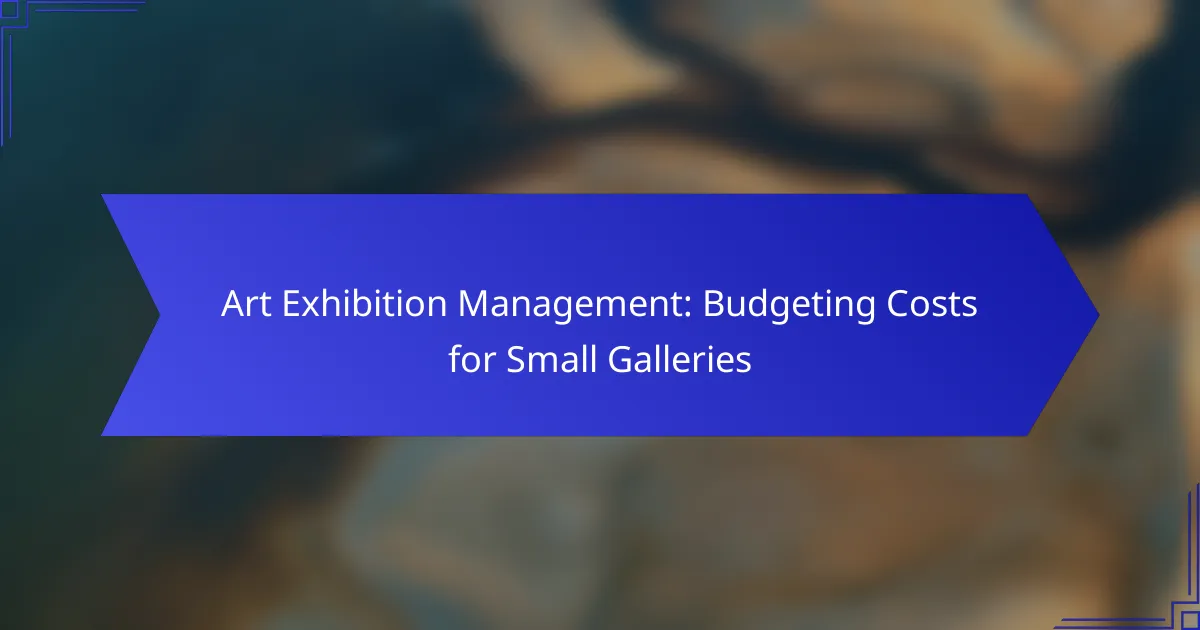Budgeting for art exhibitions in small galleries is crucial for ensuring a successful event while maximizing available resources. By identifying potential costs such as venue rental, artwork transportation, and marketing, galleries can create a well-structured budget that facilitates smooth operations. Additionally, exploring funding options like grants and sponsorships can further enhance financial planning and support the exhibition’s success.
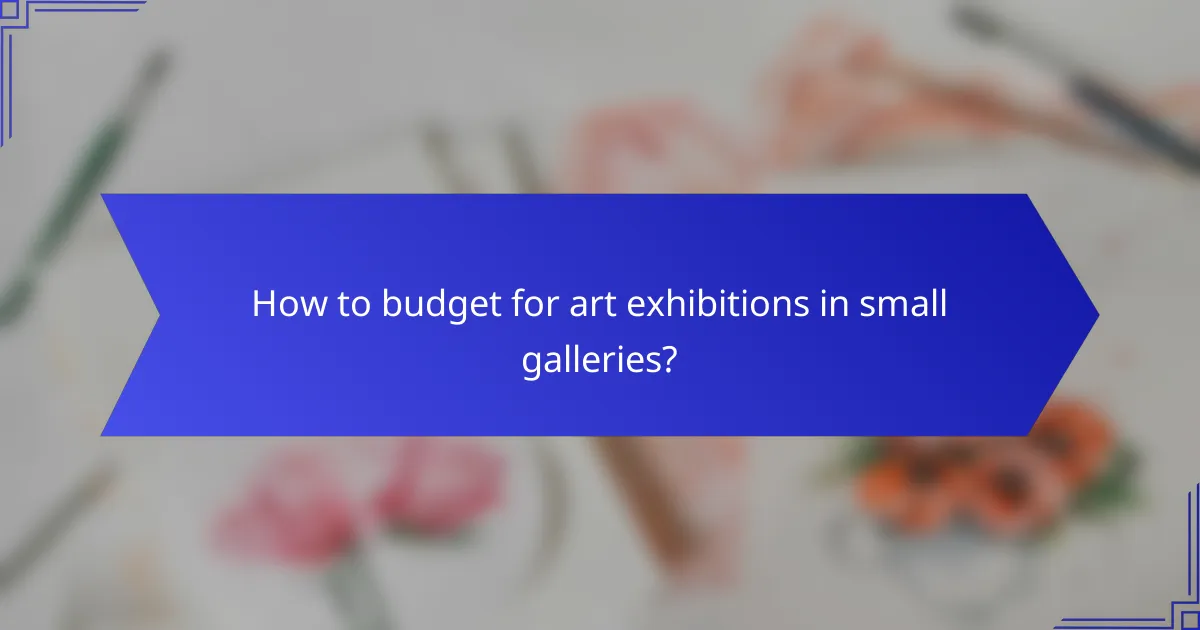
How to budget for art exhibitions in small galleries?
Budgeting for art exhibitions in small galleries involves identifying all potential costs and allocating funds accordingly. A well-structured budget ensures that the exhibition runs smoothly and maximizes the gallery’s resources.
Identify key cost categories
Begin by outlining the primary cost categories associated with your exhibition. Common categories include venue rental, marketing, installation, insurance, and labor costs. Understanding these categories helps in creating a comprehensive budget.
Consider additional expenses such as catering, utilities, and equipment rentals. Keeping track of all potential costs prevents overspending and ensures that all aspects of the exhibition are covered.
Estimate venue rental fees
Venue rental fees can vary widely based on location, size, and amenities. Small galleries may find rental costs ranging from a few hundred to several thousand dollars per day. Research local venues to compare prices and find the best fit for your budget.
In addition to the base rental fee, consider any additional charges for utilities, security, or cleaning services. Always ask for a detailed breakdown of costs to avoid surprises.
Calculate marketing expenses
Marketing is crucial for attracting visitors to your exhibition. Allocate funds for promotional materials, social media advertising, and press releases. A typical marketing budget might range from 10% to 30% of your total exhibition budget.
Utilize cost-effective strategies such as social media campaigns and email newsletters to reach your audience. Collaborating with local influencers or art bloggers can also enhance visibility without significant expenses.
Account for insurance costs
Insurance is essential to protect your artwork and venue during the exhibition. Costs for insurance can range from a few hundred to several thousand dollars, depending on the value of the artworks and the coverage required. Consult with an insurance agent to determine the appropriate coverage for your exhibition.
Ensure that your policy covers potential damages, theft, and liability. This step is vital for safeguarding your investment and providing peace of mind during the event.
Include installation and labor costs
Installation and labor costs are often overlooked but can significantly impact your budget. Factor in expenses for hiring professional installers, which can range from hourly rates to flat fees based on the complexity of the installation. Consider the time required for setup and takedown as well.
Additionally, if you plan to have volunteers or staff assisting, include any associated costs such as training or stipends. Proper planning in this area ensures a smooth installation process and a successful exhibition launch.

What are the common costs associated with art exhibitions?
Common costs for art exhibitions include venue rental, artwork transportation, insurance, and marketing. Understanding these expenses helps small galleries budget effectively and ensure a successful event.
Venue rental costs
Venue rental costs can vary significantly based on location, size, and duration of the exhibition. Small galleries should expect to pay anywhere from a few hundred to several thousand dollars for a space, depending on its prominence and amenities.
When selecting a venue, consider factors such as foot traffic, accessibility, and the overall atmosphere. It’s often beneficial to negotiate terms or seek out community spaces that may offer lower rates or sponsorship opportunities.
Artwork transportation fees
Transporting artwork safely is crucial and can incur various fees, including shipping, handling, and insurance during transit. Costs may range from low hundreds to thousands of dollars, depending on the distance and the value of the pieces being moved.
To minimize transportation fees, consider local artists or artworks that can be delivered by hand. Always ensure that the transportation method chosen provides adequate protection for the artwork to prevent damage.
Insurance premiums
Insurance premiums are essential for protecting artworks against theft, damage, or loss during the exhibition. Premiums can vary widely based on the value of the artwork and the coverage level, typically ranging from 1% to 3% of the total value of the pieces insured.
It’s advisable to consult with an insurance broker who specializes in art to find the best policy for your needs. Ensure that the coverage includes both transportation and exhibition periods to avoid gaps in protection.
Marketing and promotional expenses
Marketing and promotional expenses are vital for attracting visitors to your exhibition. Costs can include printing flyers, social media advertising, and hosting opening receptions, which may total from a few hundred to several thousand dollars.
To manage these costs effectively, leverage free or low-cost marketing channels, such as social media and community partnerships. Creating an engaging online presence can significantly increase visibility without breaking the budget.
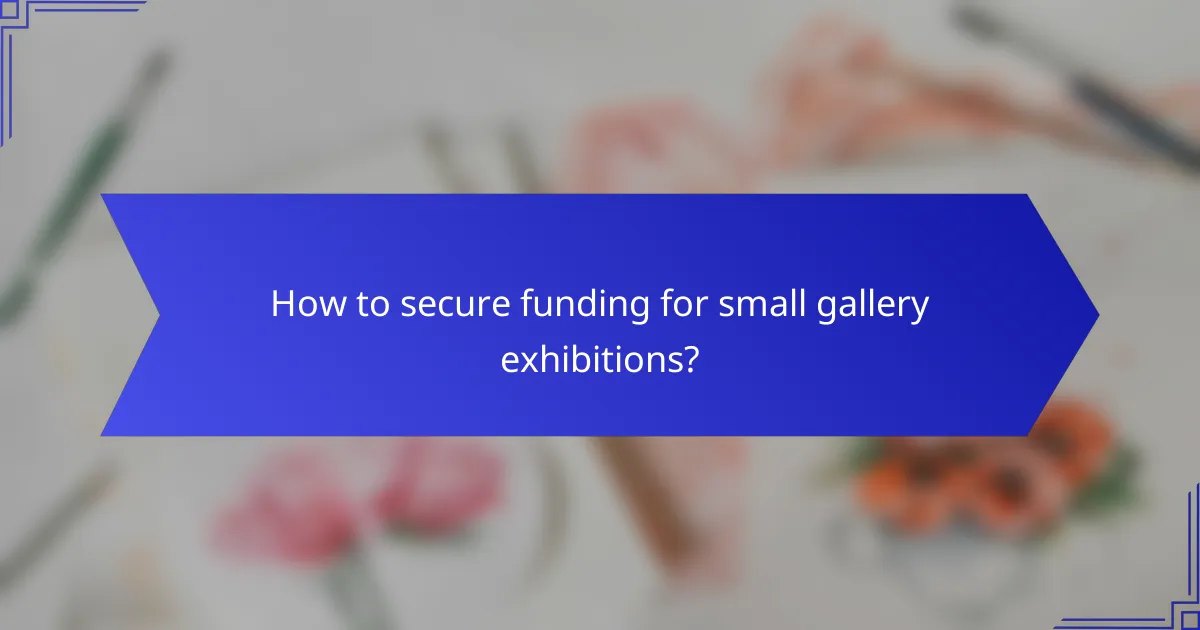
How to secure funding for small gallery exhibitions?
Securing funding for small gallery exhibitions involves exploring various financial sources such as grants, sponsorships, and crowdfunding. Each option has its own advantages and considerations that can significantly impact your exhibition budget.
Apply for grants from art foundations
Applying for grants from art foundations can provide substantial financial support for small gallery exhibitions. Many foundations offer funding specifically for visual arts, and the application process typically requires a detailed project proposal, budget outline, and timeline.
Research local and national art foundations that align with your gallery’s mission. Consider applying for grants that range from a few hundred to several thousand dollars, depending on the foundation’s size and focus. Be mindful of deadlines and eligibility criteria to improve your chances of success.
Seek sponsorship from local businesses
Local businesses can be valuable sponsors for small gallery exhibitions, providing financial support or in-kind contributions such as materials or services. Building relationships with businesses that share a community interest in the arts can lead to mutually beneficial partnerships.
When seeking sponsorship, prepare a clear proposal outlining the benefits for the business, such as promotional opportunities during the exhibition. Sponsorship amounts can vary widely, so consider offering different levels of sponsorship to attract a range of contributions.
Utilize crowdfunding platforms
Crowdfunding platforms offer a way to raise funds directly from the community for small gallery exhibitions. Websites like Kickstarter or GoFundMe allow you to present your project and set a funding goal, encouraging individuals to contribute.
To maximize your crowdfunding efforts, create a compelling campaign that includes engaging visuals and a clear explanation of how the funds will be used. Aim for a funding goal that reflects your budget needs, and consider offering rewards for different contribution levels to incentivize donations.
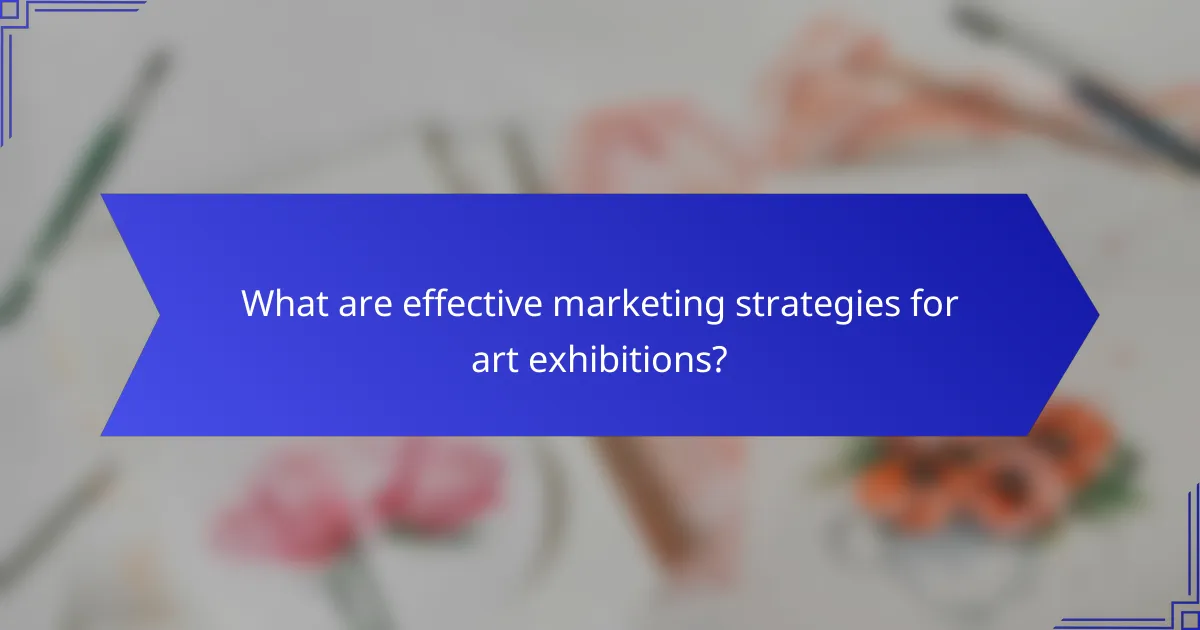
What are effective marketing strategies for art exhibitions?
Effective marketing strategies for art exhibitions include leveraging social media, collaborating with local influencers, and utilizing email marketing campaigns. These approaches can significantly enhance visibility and attract a diverse audience to small galleries.
Leverage social media advertising
Social media advertising is a powerful tool for promoting art exhibitions. Platforms like Instagram and Facebook allow galleries to target specific demographics, ensuring that the promotional content reaches potential visitors who are interested in art.
Consider allocating a budget for paid ads, focusing on visually appealing content that showcases the artwork and exhibition details. A small gallery might spend a few hundred dollars to create a buzz, especially during the weeks leading up to the event.
Collaborate with local influencers
Partnering with local influencers can amplify your exhibition’s reach. Influencers who are passionate about art can share your event with their followers, creating authentic interest and engagement.
Identify influencers in your area who align with your gallery’s vision and values. Offering them exclusive previews or hosting a special event can encourage them to promote your exhibition effectively.
Utilize email marketing campaigns
Email marketing remains a cost-effective strategy for reaching your audience directly. Building a mailing list of art enthusiasts allows galleries to send personalized invitations and updates about upcoming exhibitions.
Craft engaging emails that highlight the exhibition’s theme, featured artists, and any special events. Aim for a clear call to action, such as RSVP links or ticket purchase options, to drive attendance.
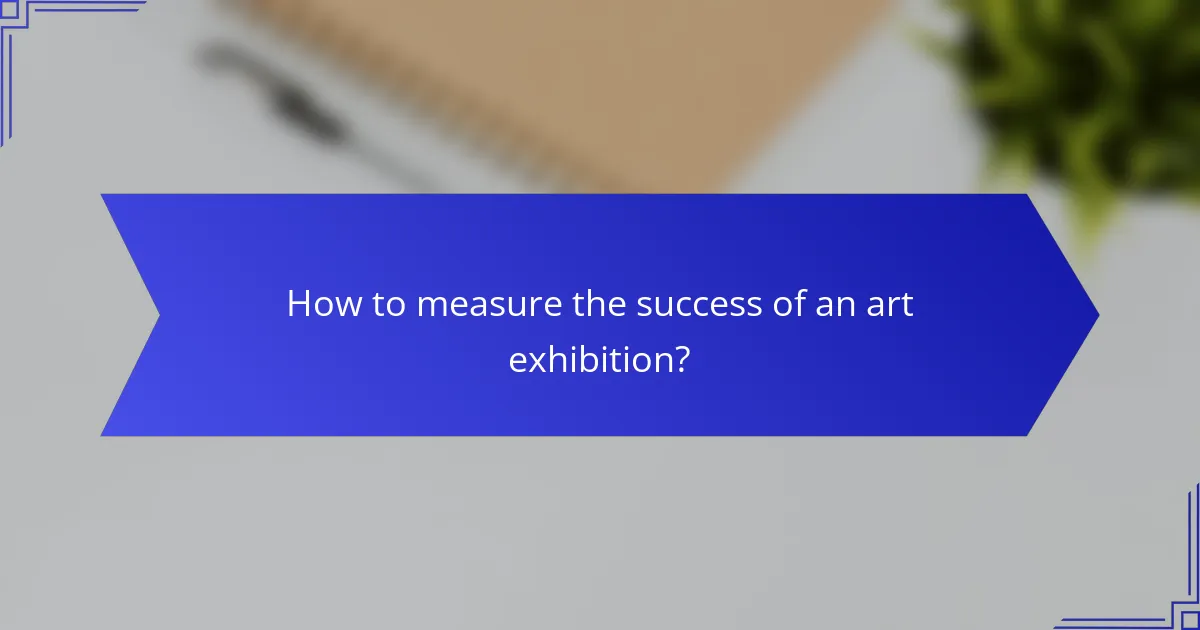
How to measure the success of an art exhibition?
Measuring the success of an art exhibition involves evaluating various factors such as visitor attendance, sales, and audience engagement. These metrics provide insights into how well the exhibition resonated with the public and its overall impact on the gallery.
Visitor Attendance
Visitor attendance is a primary indicator of an exhibition’s success. Tracking the number of guests can help galleries understand their reach and popularity. For small galleries, aiming for a few hundred to a few thousand visitors over the exhibition’s duration can be a realistic target.
Consider using ticket sales or registration systems to gather data on attendance. Additionally, monitoring peak visiting times can inform future scheduling and marketing strategies.
Sales and Revenue
Sales generated from the exhibition are crucial for assessing financial success. This includes not only artwork sales but also merchandise and ticket revenue. Small galleries should set realistic sales goals based on past exhibitions, typically ranging from a few hundred to several thousand euros.
Keep track of the average sale price and the number of artworks sold to gauge performance. Offering limited editions or exclusive pieces can also boost sales during the exhibition.
Audience Engagement
Audience engagement reflects how well the exhibition connects with visitors. This can be measured through feedback forms, social media interactions, and participation in events like artist talks or workshops. High engagement often correlates with positive visitor experiences.
Consider implementing surveys to gather visitor feedback on their experience. Engaging with visitors through social media before, during, and after the exhibition can also enhance community involvement and interest.
Media Coverage and Publicity
Media coverage can significantly influence the perceived success of an exhibition. Positive reviews from art critics, features in local publications, and mentions on social media platforms can enhance visibility and attract more visitors.
To maximize media coverage, create press releases and invite local journalists and influencers to the opening. Tracking mentions in the press can provide insights into the exhibition’s reach and impact.
Post-Exhibition Analysis
Conducting a post-exhibition analysis is essential for understanding overall success. This includes reviewing attendance numbers, sales data, and audience feedback to identify strengths and areas for improvement. Small galleries should compile this data into a report for future reference.
Use this analysis to inform planning for future exhibitions, adjusting strategies based on what worked well and what did not. Regularly reviewing these metrics can help refine the gallery’s approach and enhance future exhibitions.
